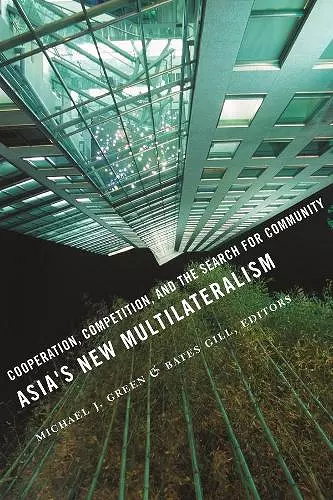Asia's New Multilateralism
Cooperation, Competition, and the Search for Community
Bates Gill editor Michael J Green editor
Format:Paperback
Publisher:Columbia University Press
Published:13th Mar '09
Currently unavailable, and unfortunately no date known when it will be back

Michael J. Green and Bates Gill have given those of us who think and write about Asia, but are not Asianists, just what we need: a book that puts the bewildering array of multilateral asian institutions into a context we can understand. The individual chapters are grouped into two parts, one providing national perspectives on multiplying multilateral institutions, the other treating the economic, security, and governance issues raised by this peculiar phenomenon. The introductory chapter brilliantly frames and introduces the well-written, lean, and useful pieces contributed by distinguished authors. Most useful is the volume's crisp identification of the tensions involved in Asian multilateralism, from soaring rhetoric to anemic performance, from 'budding Asianization' to an embrace of the Pacific community, and from enthusiasm for institution building to an acceptance of ad hoc 'minilateral' groups. In the end, the book serves as the best available realist's guide to the complex and important political reality that defines Asia today. This book is that rare item: an edited volume that is coherent, analytical, and informative. It is the best recent book on multilateralism in the region and must be required reading for teachers and students of international relations in the Asia-Pacific. -- Evelyn Goh, University of London
Traditionally, stability in Asia has relied on America's bilateral alliances with Japan, Australia, and the Republic of Korea. Yet in recent years, emergent and more active multilateral forums--such as the Six-Party Talks on North Korea and the East Asia Summit--have taken precedence, engendering both cooperation and competition while reflecting the local concerns of the region. Some are concerned that this process is moving toward less-inclusive, bloc-based "talking shops" and that the future direction and success of these arrangements, along with their implications for global and regional security and prosperity, remain unclear. The fifteen contributors to this volume, all leading scholars in the field, provide national perspectives on regional institutional architecture and their functional challenges. They illuminate areas of cooperation that will move the region toward substantive collaboration, convergence of norms, and strengthened domestic institutions. They also highlight the degree to which institution building in Asia--a region composed of liberal democracies, authoritarian regimes, and anachronistic dictatorships--has become an arena for competition among major powers and conflicting norms, and assess the future shape of Asian security architecture.
An excellent textbook for students and scholars in international relations, political science, and Asian studies, and even for diplomats and policy makers. -- Alon Levkowitz H-US-Japan
ISBN: 9780231144438
Dimensions: unknown
Weight: unknown
400 pages